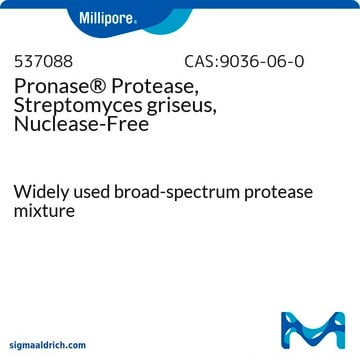PRON-RO
Roche
Pronase
from Streptomyces griseus
Synonym(s):
non-specific protease
About This Item
Recommended Products
biological source
Streptomyces griseus
Quality Level
sterility
non-sterile
form
lyophilized powder
packaging
pkg of 1 g (10165921001)
pkg of 5 g (11459643001)
manufacturer/tradename
Roche
concentration
0.5-2 mg/mL
parameter
35-40 °C optimum reaction temp.
technique(s)
DNA extraction: suitable
color
white
optimum pH
7.0-8.0
pH range
6.0-9.0
solubility
water: soluble 10-20 g/L
suitability
suitable for molecular biology
NCBI accession no.
application(s)
life science and biopharma
foreign activity
Deoxyribonuclease <0.002 U/mg ( based on lyoph.)
Ribonuclease <0.002 U/mg ( based on lyoph.)
storage temp.
2-8°C
Gene Information
Streptomyces griseus ... SGR_RS27460(6214424)
General description
Specificity
Application
Biochem/physiol Actions
Unit Definition
Preparation Note
The preparation contains 20% calcium acetate for stability. It is free of starch as per the current Quality Control Procedures.The activity of a diluted solution containing 0.01–0.1 M calcium was stable over 24 hours at neutral pH at 4 to 8 °C. Pronase is also protected from heat inactivation by low levels of calcium.
Working concentration: 0.5 to 2 mg/ml
Working solution: Solvent is recommended in distilled water.
Stock solution is prepared by adding pronase powder to distilled water (10 to 20 mg/ml).
Storage conditions (working solution): -15 to -25 °C
Reconstitution
Storage and Stability
Other Notes
Signal Word
Danger
Hazard Statements
Precautionary Statements
Hazard Classifications
Eye Irrit. 2 - Resp. Sens. 1 - Skin Irrit. 2 - STOT SE 3
Target Organs
Respiratory system
Storage Class Code
11 - Combustible Solids
WGK
WGK 1
Flash Point(F)
does not flash
Flash Point(C)
does not flash
Certificates of Analysis (COA)
Search for Certificates of Analysis (COA) by entering the products Lot/Batch Number. Lot and Batch Numbers can be found on a product’s label following the words ‘Lot’ or ‘Batch’.
Already Own This Product?
Find documentation for the products that you have recently purchased in the Document Library.
Customers Also Viewed
Our team of scientists has experience in all areas of research including Life Science, Material Science, Chemical Synthesis, Chromatography, Analytical and many others.
Contact Technical Service












